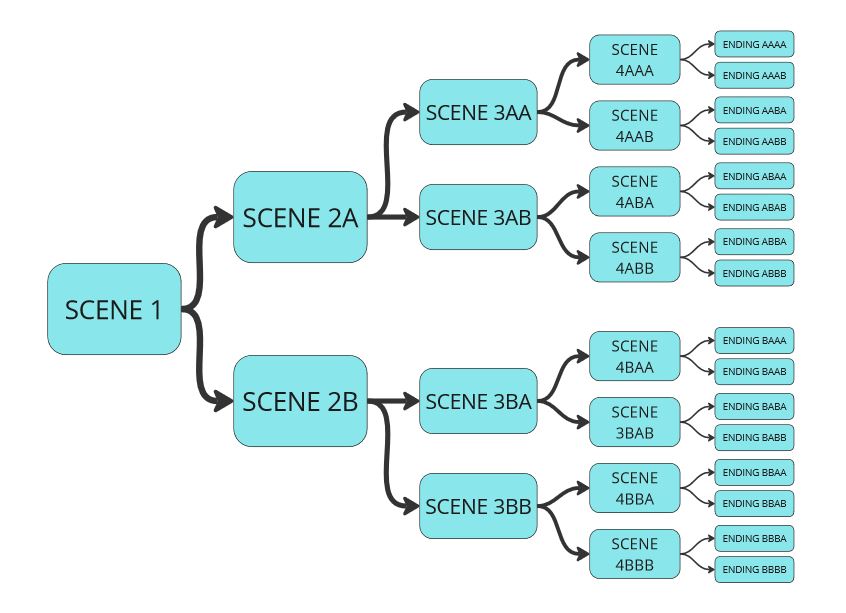Malum Opus – A Gothic Visual Novel
This article explores the design philosophy behind Malum Opus, a game that challenges players to navigate moral dilemmas, shifting alliances and supernatural forces within an isolated tower as a novice alchemist. As both the writer and programmer for the project, I’ve grappled with balancing player agency against the suffocating atmosphere that is central to Gothic fiction within the game’s narrative.
What Makes a Game Gothic?
When designing a game within a specific genre, developers must consider players’ preexisting expectations. Fantasy fulfilment is what draws players in—the promise of experiencing a world and emotions they might not encounter in reality. It’s the thrill of agency in a compelling, immersive setting. So, what fantasy would players seek to fulfil in a Gothic story? Gothic fiction is defined by:
- Characters – A mix of victims and predators, often with supernatural traits or tragic pasts, struggling between good and evil.
In a Gothic story game, these elements translate into character arcs shaped by fear, obsession, or moral decline. Players must navigate shifting trust, uncover hidden truths, and decide whether to resist or embrace the darkness—a central struggle in Malum Opus.
- Setting – Dark, isolated, and decaying environments, like abandoned castles, fog-covered moors, and labyrinthine mansions.
- Themes – Supernatural elements, forbidden knowledge, revenge, and moral corruption. Fate and doom are often foreshadowed with omens.
Branching Design and Narrative Systems
To balance player agency with a tightly woven Gothic narrative, Malum Opus employs a bottleneck narrative structure: while players shape moment-to-moment interactions, key plot points serve as convergence moments, ensuring a cohesive yet dynamic story. As discussed in The Game Narrative Toolbox, true agency doesn’t come from endless branching but from high reactivity—where the world and characters remember and respond to player choices.
To execute its narrative design, Malum Opus features three key mechanics:
- Perception System – NPCs shape their perception of the player based on their words and actions, ultimately determining what kind of a relationship dynamic they share.
- Profiling System – The player’s choices shape the protagonist’s identity (personality traits, fears, skills, backstory, etc.), and by tracking these stats, the game is able to provide the opportunities for creating a fitting character arc – be it redemption or
corruption – to the player.
- Alchemy Minigame – A gameplay mechanic that invites the player to feel like a true
scholar through studying alchemical texts, crafting their own recipes and carrying out
experiments.
These systems ensure that while the core story is structured, each player’s journey through
Malum Opus feels uniquely their own—and deeply Gothic.
Character Perception System: Making NPCs Dynamic
In Malum Opus, the siblings Cain and Caroline Donovan are fellow disciples of the protagonist. Cain, a calculating toxicologist, will stop at nothing to achieve his ambitions, while Caroline, a loyal metallurgist, hides her anxieties and past regrets behind humour and kindness. The player
may feel compelled to challenge or ally with either sibling, depending on their own morality and goals.
State Machines
Inspired by Emily Short’s article on Narrative States, each sibling’s perception of the player is tracked using a state machine based on three axes: Distrust, Affection, Disrespect/Protectiveness.
These metrics determine relationship statuses, which dictate dialogue and plot outcomes. For example, if the player randomly insults Cain, he will respond differently depending on whether he perceives the player as a…
- Rival (30%+ Distrust and 30%+ Affection): Cain seems unbothered: “The sentiment is
mutual.” - Pawn (70%+ Disrespect): Cain feigns concern: “What’s put you in such a sour mood?”
- Friend (70%+ Affection): “Is this a joke?” he asks, genuinely puzzled.
- Follower (30%+ Disrespect and 30%+ Affection): “Mind your tone,” he chides coldly.
- Nuisance (30%+ Distrust and 30%+ Disrespect): Cain rolls his eyes and ignores the
player. - Nemesis (70%+ Distrust): Cain throws the player a resentful glare and leaves the room.
These percentages are shaped by the encounters between the player and the characters. In the following example, the player had previously lied about their background but then slips up mid-conversation:
Caroline pauses, her expression souring: “Interesting. You’ve told me something completely different when you arrived. How is that?”
An apologetic response makes her assume that the player feels either insecure or unsafe, which increases her Protectiveness, while doubling down on the lie spikes Distrust.
Late-Game Branching
The player’s statuses directly impact characters’ late-game decisions:
- A Friend player may be able to dissuade Cain from going down a dark path.
- A Nemesis player is a threat to Cain’s plan, so he makes an attempt to eliminate them.
- With a Sibling player (30%+ Protectiveness and 30%+ Affection), Caroline actively tries
to keep them out of danger, often at her own expense. - An Equal player (30%+ Distrust and 30%+ Affection) means Caroline lets them take
charge in high risk scenarios.
Dynamic Character Arcs
The player’s choices have the power to influence Cain’s and Caroline’s character development:
- Cain: A kind player softens his cynicism, making him value empathy. A ruthless player fuels his ambition, culminating in megalomania.
- Caroline: A neurotic player amplifies her protective anxiety, while a reliable player helps her overcome insecurities.
The system avoids combinatorial explosion by using additive dialogue (conditional lines) and alternate paths (mutually exclusive scenes). Variables track key interactions, like lies detected or promises broken, ensuring NPCs remember pivotal moments.
Player Profiling System: Crafting a Unique Protagonist
In Malum Opus, the profiling system tracks the protagonist’s identity through dynamic stats, ensuring that the choices the player makes come together in a compelling character arc. The design draws from Dan Fabulich’s articles on delayed branching and player stats.
Mechanics of Profiling
The system tracks the following traits:
- Primary Motivation (only one option is active): Power, Philanthropy, Immortality, Legacy, Truth, Survival.
- Strengths: Perception, Charm, Knowledge.
- Weaknesses: Neuroticism, Naivety, Cowardice.
- Moral Alignment: Cruel/Kind, Lawful/Chaotic.
The game also stores key facts about the player’s character, such as their background, phobias, etc.
Stats can greatly affect the player’s roleplaying experience:
- A neurotic protagonist is more susceptible to the influences of supernatural forces.
- Low charm means the player’s attempts at lying are clumsy, leading to Distrust.
- A player who is naive is more likely to be taken advantage of.
- Having Power as a primary motivation locks compassionate options with Caroline, instead presenting an alternative option to feign kindness or lie about your opinions— until a redemption arc is triggered.
- If the player’s primary motivation is Philanthropy but they keep choosing cruel options on many occasions, this cognitive dissonance might lead to a moral breakdown, causing their neurotic stat to skyrocket.
The purpose of the system is to allow the player to craft a protagonist with a rich internal world
and the potential for an exciting character arc—whether it leads to redemption or corruption.
The Alchemy Minigame
Designed to immerse players in the role of a scholar, the minigame blends real-world alchemical philosophy (rooted in historical texts like the Emerald Tablet) with puzzle solving.
Gameplay Loop: From Theory to Experiment
- Study & Decipher: Players read chapters on alchemical principles (e.g., the four elements, transmutation). Each ends with a riddle where key terms are replaced by glyphs. Solving these unlocks new symbols in their dictionary.
- Example: A riddle about “purification through fire” might hide the alchemical glyph for ignis (fire), requiring contextual deduction.
- Craft Recipes: Using decoded glyphs, players can craft recipes.
- Experiment: Players gather ingredients and apply their recipes in practice. Success yields achievements (e.g., “Master of Mercury”) or unique interactions, while failure triggers comedic encounters:
- A flawless elixir impresses Caroline: “At this point you’re going to put Cain out of work.”
- A botched explosion draws Cain’s ire: “Were you trying to collapse the tower?”
Narrative Integration
Though optional, the minigame enriches the story and enforces player agency:
- Becoming proficient in the arts allows the player to comprehend the true nature of supernatural forces at play.
- The player gets to choose what kind of alchemist they want to be in the selection of their study materials and the recipes they craft.
- The player’s successes and failures serve to affect the Perception System.
Conclusion
At its core, Malum Opus is an intricate web of narrative systems designed to immerse players in a world where choices have weight, identities evolve, and trust is as fragile as the crumbling tower they inhabit. By blending the Perception System, Player Profiling, and Alchemy Mechanics, the game ensures that choices carry narrative and mechanical consequences, reinforcing the themes of moral decay, ambition, and the pursuit of forbidden knowledge




